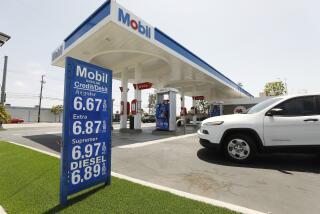Questions Raised Over the Effect of Gore’s Energy Plan
California, hands down, leads the nation in putting alternative-fuel vehicles on the road. Which so far is about the same as saying the Chicago Cubs have won more World Series than the Texas Rangers.
True, but so what?
Despite the most aggressive efforts in the nation to get motorists behind the wheel of non-gas-guzzlers, the number of such vehicles on California roads remains inconsequential--just 50,000 among 27 million registered vehicles.
California’s skimpy track record raises questions about the potential of a plan, quite similar to the Golden State’s effort, unveiled this week by Vice President Al Gore. But some environmental groups say Gore has added a twist to his proposal that may make all the difference: billions of dollars in tax credits to get oil companies and car manufacturers to develop more energy-efficient cars.
The initiative announced this week also would provide $46 billion in tax credits for consumers who buy energy-efficient cars and homes. The plan earmarks a $5,000 tax credit for hybrid vehicles--those running, say, on gas and electricity--and the credit would rise to $6,000 for vehicles that are electric or propelled by fuel cells.
Federal tax credits of up to $4,000 are currently available for purchasers of electric cars.
And California has added some local funds to sweeten the pot. Local buyback programs, which help close the gap in price between alternative fuel and the far more readily available gas-powered vehicles, provide as much as $3,000 toward the purchase of alternative fuel cars and $5,000 for electric.
Even so, the job of weaning motorists from the gasoline pump is so enormous it lends itself to cliches.
“Just like a battleship, you can’t turn it on a dime. It takes many miles to turn,” said Bob Aldrich, a spokesman for the California Energy Commission.
And this from Dettrich Allen, the general manager for Los Angeles’ environmental affairs department: “It’s like the chicken and the egg. Gas station owners say we’ve got to get more alternative-fuel cars out there before they build the infrastructure. But we’ve got to get the infrastructure out there to get people comfortable with buying the cars.”
Starting today, solo motorists will get the biggest carrot yet, with electric and compressed natural gas vehicles allowed in California carpool lanes.
Advocates of the no-emission vehicles say they are hopeful the carpool lane free pass, as well as pressing deadlines set by Air Quality Management Districts on emissions, may finally lead to a swelling of the numbers of such cars on the state’s congested and smog-prone freeways.
But that remains to be seen.
“Obviously, from the consumer point of view, it has not been a tremendous success,” said Aldrich, who said he believes it may take the type of national push proposed by Gore to make the new technology palatable to the masses.
Proponents of alternative fuels say the component Gore offers that California and other states could not is a nationwide nudge for manufacturers and fuel providers.
The vice president, who had in the past advocated higher fuel taxes as a logical step toward a better environmental policy, has taken a different tack as a candidate for president, pushing for better fuel efficiency through changes in the tax code.
The individual incentives are paired with a $75-billion plan to encourage industry to create cleaner forms of energy, including about $68 billion over 10 years to reward energy companies that dramatically reduce health-threatening pollution.
Gas prices and overall energy policy have emerged as a hot issue in this presidential election, with both Gore and Texas Gov. George W. Bush, the presumed Republican nominee, throwing punches at each other in recent weeks. With prices at the pump soaring past $2.30 in the Midwest--where Gore rolled out his proposal over three days this week--the accusations have gotten personal as both candidates look for a way to capitalize on the consumer outrage.
Bush, a former oil company executive, has said the country needs to reduce its reliance on foreign oil supplies. His campaign staff said Gore’s plans won’t accomplish that goal.
But some leading environmentalists argue that the Gore plan is more forward thinking than petroleum-based solutions like Bush’s call for the Organization of Petroleum Exporting Countries to “open the spigots” on oil production.
Robert F. Kennedy Jr. a senior attorney with the Natural Resources Defense Council, said the key has always been getting manufacturers to make alternative fuels, and the cars that run on them readily available at prices motorists can afford.
“The question is how do you do it?” he said, during a conference call arranged by the Gore campaign Thursday. “It’s a question that has always baffled the environmental community and put them at odds with the business community.”
Kennedy and others think Gore’s plan may finally answer the question.
Those who already provide alternative fuels to the public say they would have far greater strength in greater numbers. At one of only a handful of commercial stations in Los Angeles where you can pump up on compressed natural gas--99 cents a gallon right now--the vehicles that pull up almost all carry a company or city logo on their sides. Aramis Margaryan, a smog technician at the Shell station, said the smog-free cars seem the same as any other. Still, he said he’s noted how frequently the drivers have to fill up and he is in no hurry to buy one of the cars himself.
“You can’t fill it up and head all the way to Vegas,” he noted. “Where would you stop for gas?”
More to Read
Get the L.A. Times Politics newsletter
Deeply reported insights into legislation, politics and policy from Sacramento, Washington and beyond. In your inbox three times per week.
You may occasionally receive promotional content from the Los Angeles Times.











